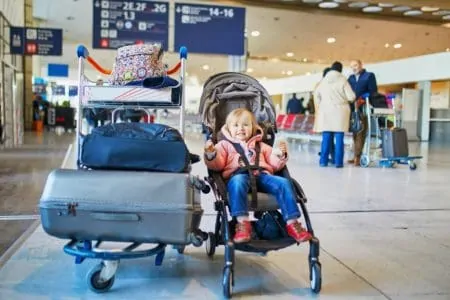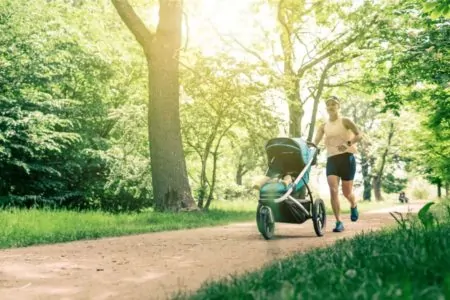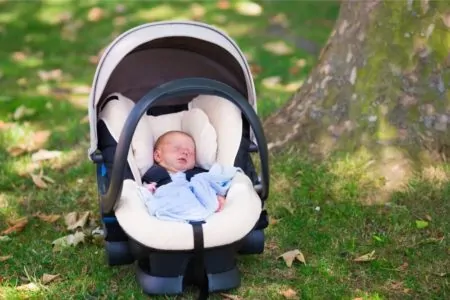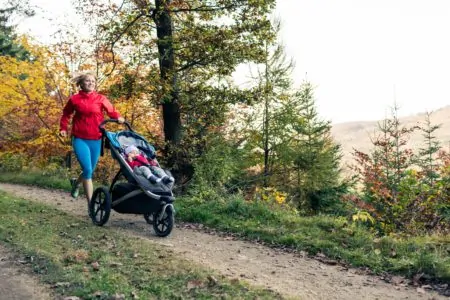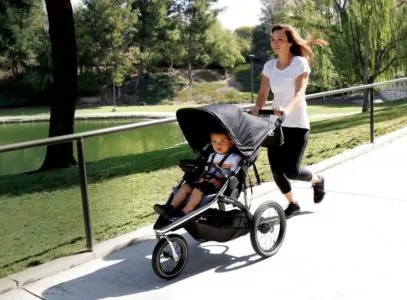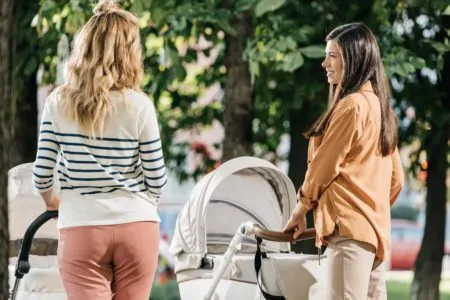Flying with car seats and strollers can be one of the most stressful aspects of traveling with children. To make it more difficult, there are no hard and fast rules that apply to all airlines and airports. That means you might find one trip is easy sailing while another is a nightmare.
So, should you take a car seat and stroller with you to the airport? Or should you leave the bulky equipment at home? After all, you can save yourself the cost of an expensive airline seat by carrying your child on your lap.
Key Takeaways
- Flying with car seats and strollers can be stressful, but they provide safety and comfort for your child during the flight.
- Car seats should be FAA-approved and fit within airplane seat dimensions; strollers must fold small enough to fit in overhead compartments.
- Checking car seats and strollers is simple at the ticket counter or gate, and using protective bags can help prevent damage and dirt.
- Research airline and airport regulations, and have a backup plan in case of damage or loss to ensure a smooth travel experience.
Why Fly With a Car Seat and Stroller?
You may wonder if it’s worth the hassle of taking your car seat and stroller on the airplane. Although it is ultimately a matter of parental choice, the American Society of Pediatrics recommends the use of a child restraint system during a flight (1). The FAA makes the same recommendations but stops short of requiring its use by law (2).
A Car Seat Protects Your Child In Flight
Many people make the mistake of assuming the FAA allows children under the age of 2 years to travel as “lap-children” because it is safe. This is not so.
Numerous crash investigations have concluded that children being held on a lap have sustained serious, and in some cases fatal, injuries (3). Unrestrained children have been injured and even died during incidents of turbulence.
Crash tests show that children who are restrained in an FAA-approved car seat are significantly more likely to survive and avoid serious injury than unrestrained children.
Car Seats Provide Comfort on The Airplane
Traveling with an infant or older child is significantly more comfortable for both parent and child when you use a car seat. Traveling in a familiar car seat can also provide a degree of reassurance for a child who may otherwise be disturbed by the disruption of travel.
Safer Than Car Seats and Strollers at Your Destination
Some parents choose to leave their car seat and stroller at home and hire equipment at their destination. This can seem like a great solution but has significant disadvantages.
- Safety equipment may not be available for rent at your destination.
- Equipment that is available may not meet the safety standards we have come to expect at home, such as adhering to the expiration dates for car seats.
- Even if you are traveling domestically, you cannot be sure that any equipment you rent has been correctly maintained.
The Best Car Seats and Strollers for Flying
When shopping for a car seat and stroller, the biggest mistake I made was to think that “travel systems” were a good option to travel with. Not so!
Our travel system was excellent for taking our sleeping babies from the truck without waking them, but the stroller was not the easiest thing to fold and unfold. As a result, we bought a smaller, lightweight stroller to use when we travel.
The trouble with many lightweight strollers is that, unless the seat reclines so it is completely flat, they can’t be used for newborns. Until a baby can sit up and hold its head steady, any upright stroller is unsuitable.
After much research, we bought the Mountain Buggy Nano Duo Stroller because it is infant car seat ready. We could keep our newborns in their existing seats and the stroller folds up small enough to fit in the overhead locker on most flights. This meant no checking the stroller at either the baggage check or the gate, and no having to wait to pick up the stroller at the other end.
The majority of car seats will fit in an airplane seat and we use the Chico KeyFit 30 because it is relatively lightweight, which becomes increasingly important in larger airports where you have a long walk to the airplane. You don’t want to feel like you’re training for a weight-lifting competition — you’re just trying to get your baby on the plane.
How to Check a Car Seat or Stroller
It feels like every “first” when you have a child is fraught with stress. Flying with a car seat or stroller is no exception. Don’t worry, it’s not nearly as difficult or stressful as you might think if you plan ahead and choose your gear carefully.
The thing to remember is that no matter where you check your items, remove any attached items such as toys and cup holders. Then make sure you have secured all straps. If you are not using a check-in bag, this will minimize the chances of something getting caught and causing damage.
At the Ticket Counter/Curbside
Checking your stroller or car seat at the curbside or the ticket counter is as simple as checking any other baggage. You tell the airline’s personnel that you would like to check your stroller or car seat. You will be given a luggage tag to attach to your checked item.
At the Gate
As with check-in, the process at the gate is simple. The flight attendant or gate staff will give you a label to attach securely to your car seat or stroller. I always advise asking a staff member for the label as soon as you arrive at the gate, even if you are not checking your item immediately.
This way, you can attach your label as soon as possible and the whole checking process will be streamlined when you are ready to board.
We once inadvertently delayed a flight because we waited until boarding only to discover that the staff member at the gate didn’t have any luggage labels. It took almost 20 minutes to resolve the issue. Flight delayed, fellow passengers upset, lesson learned.
Can I Bring My Car Seat or Stroller as a Carry-On?
The rules for carrying a car seat or stroller onto the airplane are the same as for any other piece of luggage. If it folds up small enough to fit into the overhead compartment, it is generally okay. If not, you will have to check the item.
The only exception to this is when you buy a seat for your child and use your car seat in the airplane seat.
How to Protect a Stroller or Car Seat When Flying
If you already have a lightweight stroller that you plan to check at baggage or the gate, you might want to consider a flight check stroller bag. They do not prevent any structural damage, but these bags do stop your stroller from getting dirty in the baggage hold.
I am a big fan of the Alnoor USA Flight Check Bag. It has comfortable padded straps which make it easy to carry like a backpack, leaving your hands free to juggle the dozens of other things you need to carry when traveling with little ones.
On transatlantic flights, we always buy a seat for our children who are under 2 years old and ensure they are secure in their car seats for the flight. However, if this is not an option or if you are on a short hop flight, you might choose to check your car seat. In this case, the JL Childress Check Bag will keep your car seat clean, but will not protect it from structural damage.
For more protection, the JL Childress padded car seat bag is your best option. It provides a padded cocoon for your car seat, and it has padded straps that allow you to carry it comfortably and hands-free.
Using a Car Seat on The Plane
To use your car seat on an airplane, the seat must be FAA-approved. The majority of car seats available in the U.S. today are approved, but it’s important to double-check the sticker is attached and easily accessible.
It’s not unusual for a flight attendant to double-check that your car seat is compliant and ask to see the sticker. This is not the time to discover one of your kids has peeled the sticker off.
Car seats can only be used in seats where they will not block the exit of other passengers. This usually means a window seat or on airplanes with center rows, the middle seats. Car seats cannot be used in emergency exit rows.
As previously mentioned, it’s important to ensure your car seat will fit in a standard airplane seat. In most cases a coach seat is 16 inches wide, so your car seat must be this width at a maximum. However, if your car seat does not fit the airplane seat, the airline is responsible for accommodating you in another seat if at all possible (4).
Install your car seat according to the manufacturer’s instructions. If you have a rear-facing infant seat, it should be rear-facing in the airplane.
Some flight attendants still instruct parents to place these seats in a forward-facing position. For this reason, have the appropriate FAA regulations bookmarked on your phone. You can then share them with the attendant (5).
If the attendant still insists you place your seat in a forward-facing position, you have a choice. Either place the seat facing forward or argue your case. The downside of taking the second option is there is the possibility you may be removed from the flight.
Other Tips for Flying with Car Seats and Strollers
Having flown thousands of miles with our little ones, I have a few top tips for flying with car seats and strollers.
- If you are planning to use your car seat on the airplane or take your folding stroller on as a carry-on, check that they will fit for every flight. Each airline has its own size regulations and what was okay on your last flight may not be okay on your next.
- Wherever possible, find out how strollers and car seats are handled at the other end of your flight. Will they be available at landing, on the baggage claim carousel, or will they be at the oversized luggage counter?
- If you are checking your stroller and/or car seat, consider a baby sling for use in the airport. This can be a lifesaver if you have to go through passport control until you can grab your stroller again.
- Photograph your car seat and stroller before leaving home. This makes it easier to make a damage claim should anything happen to your car seat or stroller while it is checked baggage.
- Before you travel, look into the availability of car seats and strollers at your destination, even if you are flying with your own. Should your car seat or stroller be badly damaged and unusable, or if it becomes lost in transit, it is useful to have a back-up plan already in place.
In The End
Traveling with a car seat and stroller doesn’t have to be complicated and stressful. Checking your items as baggage is as simple as checking your suitcase or backpack. Even checking a car seat or stroller at the gate is relatively simple.
The key to making everything go smoothly is carrying out plenty of research to ensure you are equipped with the knowledge and the gear that keeps your little one safe. But remember you also have to meet the wide variety of airline and airport regulations.
